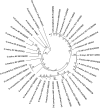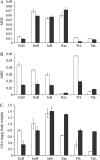Novel hydroxycinnamoyl-coenzyme A quinate transferase genes from artichoke are involved in the synthesis of chlorogenic acid
- PMID: 20431089
- PMCID: PMC2899911
- DOI: 10.1104/pp.109.150144
Novel hydroxycinnamoyl-coenzyme A quinate transferase genes from artichoke are involved in the synthesis of chlorogenic acid
Abstract
Artichoke (Cynara cardunculus subsp. scolymus) extracts have high antioxidant capacity, due primarily to flavonoids and phenolic acids, particularly chlorogenic acid (5-caffeoylquinic acid [CGA]), dicaffeoylquinic acids, and caffeic acid, which are abundant in flower bracts and bioavailable to humans in the diet. The synthesis of CGA can occur following different routes in plant species, and hydroxycinnamoyl-coenzyme A transferases are important enzymes in these pathways. Here, we report on the isolation and characterization of two novel genes both encoding hydroxycinnamoyl-coenzyme A quinate transferases (HQT) from artichoke. The recombinant proteins (HQT1 and HQT2) were assayed after expression in Escherichia coli, and both showed higher affinity for quinate over shikimate. Their preferences for acyl donors, caffeoyl-coenzyme A or p-coumaroyl-coenzyme A, were examined. Modeling and docking analyses were used to propose possible pockets and residues involved in determining substrate specificities in the HQT enzyme family. Quantitative real-time polymerase chain reaction analysis of gene expression indicated that HQT1 might be more directly associated with CGA content. Transient and stable expression of HQT1 in Nicotiana resulted in a higher production of CGA and cynarin (1,3-dicaffeoylquinic acid). These findings suggest that several isoforms of HQT contribute to the synthesis of CGA in artichoke according to physiological needs and possibly following various metabolic routes.
Figures







Similar articles
-
The isolation and mapping of a novel hydroxycinnamoyltransferase in the globe artichoke chlorogenic acid pathway.BMC Plant Biol. 2009 Mar 18;9:30. doi: 10.1186/1471-2229-9-30. BMC Plant Biol. 2009. PMID: 19292932 Free PMC article.
-
Isolation and functional characterization of a cDNA coding a hydroxycinnamoyltransferase involved in phenylpropanoid biosynthesis in Cynara cardunculus L.BMC Plant Biol. 2007 Mar 20;7:14. doi: 10.1186/1471-2229-7-14. BMC Plant Biol. 2007. PMID: 17374149 Free PMC article.
-
Early lignin pathway enzymes and routes to chlorogenic acid in switchgrass (Panicum virgatum L.).Plant Mol Biol. 2014 Mar;84(4-5):565-76. doi: 10.1007/s11103-013-0152-y. Epub 2013 Nov 5. Plant Mol Biol. 2014. PMID: 24190737
-
Should I stay or should I go: are chlorogenic acids mobilized towards lignin biosynthesis?Phytochemistry. 2019 Oct;166:112063. doi: 10.1016/j.phytochem.2019.112063. Epub 2019 Jul 4. Phytochemistry. 2019. PMID: 31280091 Review.
-
Evolution of rosmarinic acid biosynthesis.Phytochemistry. 2009 Oct-Nov;70(15-16):1663-79. doi: 10.1016/j.phytochem.2009.05.010. Epub 2009 Jun 25. Phytochemistry. 2009. PMID: 19560175 Review.
Cited by
-
Strategies to Modulate Specialized Metabolism in Mediterranean Crops: From Molecular Aspects to Field.Int J Mol Sci. 2021 Mar 12;22(6):2887. doi: 10.3390/ijms22062887. Int J Mol Sci. 2021. PMID: 33809189 Free PMC article. Review.
-
Phenylpropanoids Accumulation in Eggplant Fruit: Characterization of Biosynthetic Genes and Regulation by a MYB Transcription Factor.Front Plant Sci. 2016 Jan 28;6:1233. doi: 10.3389/fpls.2015.01233. eCollection 2015. Front Plant Sci. 2016. PMID: 26858726 Free PMC article.
-
Integrative analysis of genome-wide association studies of polyphenols in apple fruits identifies the MdDof2.4-MdPAT10 module that promotes procyanidin accumulation.Hortic Res. 2024 Dec 12;12(3):uhae349. doi: 10.1093/hr/uhae349. eCollection 2025 Mar. Hortic Res. 2024. PMID: 40061802 Free PMC article.
-
Versatility in acyltransferase activity completes chicoric acid biosynthesis in purple coneflower.Nat Commun. 2021 Mar 10;12(1):1563. doi: 10.1038/s41467-021-21853-6. Nat Commun. 2021. PMID: 33692355 Free PMC article.
-
Hybrid transcriptome sequencing approach improved assembly and gene annotation in Cynara cardunculus (L.).BMC Genomics. 2020 Aug 21;21(1):317. doi: 10.1186/s12864-020-6670-5. BMC Genomics. 2020. PMID: 32819282 Free PMC article.
References
-
- Agarwal R, Mukhtar H. (1996) Cancer chemoprevention by polyphenols in green tea and artichoke. Adv Exp Med Biol 401: 35–50 - PubMed
-
- Azzini E, Bugianesi R, Romano F, Di Venere D, Miccadei S, Durazzo A, Foddai MS, Catasta G, Linsalata V, Maiani G. (2007) Absorption and metabolism of bioactive molecules after oral consumption of cooked edible heads of Cynara scolymus L. (cultivar Violetto di Provenza) in human subjects: a pilot study. Br J Nutr 97: 963–969 - PubMed
-
- Berman HM, Battistuz T, Bhat TN, Bluhm WF, Bourne PE, Burkhardt K, Feng Z, Gilliland GL, Iype L, Jain S, et al. (2002) The Protein Data Bank. Acta Crystallogr D Biol Crystallogr 58: 899–907 - PubMed
-
- Brown JE, Rice-Evans CA. (1998) Luteolin-rich artichoke extract protects low density lipoprotein from oxidation in vitro. Free Radic Res 29: 247–255 - PubMed
-
- Bundy R, Walker AF, Middleton RW, Wallis C, Simpson HC. (2008) Artichoke leaf extract (Cynara scolymus) reduces plasma cholesterol in otherwise healthy hypercholesterolemic adults: a randomized, double blind placebo controlled trial. Phytomedicine 15: 668–675 - PubMed
Publication types
MeSH terms
Substances
Associated data
- Actions
- Actions
- Actions
- Actions
- Actions
Grants and funding
LinkOut - more resources
Full Text Sources
Other Literature Sources
Research Materials

